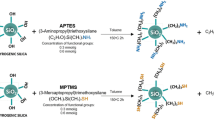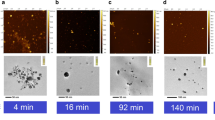Abstract
Silver nanoparticles dispersed in a silica matrix were made by the consolidation of a Ag-attached silica colloid, which was synthesized via the electrolysis of a pure Ag electrode, the reduction of Ag+ ions by H2, and the nucleation and growth of Ag particles on the silica nanoparticles in water. This simple process produced Ag/silica nanocomposites with a high concentration and narrow size distribution of nanoparticles, which was confirmed by transmission electron microscopy and x-ray diffraction. As estimated by Raman and photoluminescence measurements, the quantity of broken oxygen bonds was increased with increasing Ag concentration due to the intervention of Ag ions as structural modifiers in the silica network structure. Ag ions in the matrix are probably a residue of the Ag+ ions that could not be reduced by H2 during the electrolysis/reduction reaction. The optical-absorption spectra and the HCl-soaking test suggested that a chemical-interface damping effect, which was caused by electron transfer from the metal particles to the oxide matrix, dominates the optical-absorption properties in this system.
Similar content being viewed by others
References
E. Borsella, G. De Marchi, F. Caccavale, F. Gonnella, G. Mattei, P. Mazzolodi, G. Battaglin, A. Quaranta, and A. Miotello, Silver cluster formation in ion-exchanged waveguides: Processing technique and phenomenological model, J. Non-Cryst. Solids 253, 261 (1999).
P.W. Wang, Thermal stability of silver in ion-exchanged soda lime glasses, J. Vac. Sci. Technol. A 14, 465 (1996).
P. Gangopadhyay, R. Kesavamoorthy, K.G.M. Nair, and R. Dhandapani, Raman scattering studies on silver nanoclusters in a silica matrix formed by ion-beam mixing, J. Appl. Phys. 88, 4975 (2000).
H. Hofmeister, S. Thiel, M. Dubiel, and E. Schurig, Synthesis of nanosized silver particles in ion-exchanged glass by electron beam irradiation, Appl. Phys. Lett. 70, 1694 (1997).
G. Yang, W. Wang, Y. Zhou, H. Lu, S.G. Yang, and Z. Chen, Linear and nonlinear optical properties of Ag nanocluster/BaTiO3 composite films, Appl. Phys. Lett. 81, 3969 (2002).
G. De, L. Tapfer, M. Catalano, G. Battaglin, F. Caccavale, F. Gonella, P. Mazzoldi, and R.F. Hagliund Jr., Formation of copper and silver nanometer dimension clusters in silica by the sol-gel process, Appl. Phys. Lett. 68, 3820 (1996).
U. Kreibig and M. Vollmer, Optical Properties of Metal Clusters (Springer, New York, 1999).
W. Cai, L. Zhang, H. Zhong, and G. He, Annealing of mesoporous silica loaded with silver nanoparticles within its pores from isothermal sorption, J. Mater. Res. 13, 2888 (1998).
S. Cheng, Y. Wei, Q. Feng, K-Y. Qui, J-B. Pang, S.A. Jansen, R. Yin, and K. Ong, Facile synthesis of mesoporous gold-silica nanocomposite materials via sol-gel process with nonsurfactant templates, Chem. Mater. 15, 1560 (2003).
J. Cho, Y-W. Kim, B. Kim, J-G. Lee, and B. Park, Zero-strain intercalation cathode for rechargeable Li-ion cell, Angew. Chem. Int. Ed. 42, 1618 (2003).
J.A. Lewis, Colloidal processing of ceramics, J. Am. Ceram. Soc. 83, 2341 (2000).
R.K. Iler, Reduction and aggregation of silver ions at the surface of colloidal silica, The Chemistry of Silica: Solubility, Polymerization, Colloid and Surface Properties, and Biochemistry (Wiley, New York, 1979).
D. Lawless, S. Kapoor, P. Kennepohl, D. Meisel, and N. Serpone, Reduction and aggregation of silver ions at the surface of colloidal silica, J. Phys. Chem. 98, 9619 (1994).
C. Mohr, M. Dubiel, and H. Hofmeister, Formation of silver particles and periodic precipitate layers in silicate glass induced by thermally assisted hydrogen permeation, J. Phys.: Condens. Matter 13, 525 (2001).
K.S. Gadre and T.L. Alford, Contact angle measurements for adhesion energy evaluation of silver and copper films on parylenen and SiO2 substrates, J. Appl. Phys. 93, 919 (2003).
P.A. Kralchevsky and N.D. Denkov, Capillary forces and structuring in layers of colloid particles, Curr. Opin. Colloid Interface Sci. 6, 383 (2001).
I.V. Schweigert, K.E. Lehtinen, MJ. Carrier, and M.R. Zachariah, Structure and properties of silica nanoclusters at high temperatures, Phys. Rev. B 65, 235410-1 (2002).
R.J. Hunter, Foundations of Colloidal Science (Oxford University Press, Oxford, U.K., 1986).
E. Duval, H. Portales, L. Saviot, M. Fujii, K. Sumitomo, and S. Hayashi, Spatial coherence effect on the low-frequency Raman scattering from metallic nanoclusters, Phys. Rev. B 63, 075405-1 (2001).
T. Kim, J. Oh, B. Park, and K.S. Hong, Correlation between strain and dielectric properties in ZrTiO4 thin films, Appl. Phys. Lett. 76, 3043 (2000).
Y. Kim, J. Oh, T-G. Kim, and B. Park, Effect of microstructures on the microwave dielectric properties of ZrTiO4 thin films, Appl. Phys. Lett. 78, 2363 (2001).
H. Zhang, B. Gilbert, F. Huang, and J.F. Banfield, Water-driven structure transformation in nanoparticles at room temperature, Nature 424, 1025 (2003).
C. McGinley, M. Riedler, and T. Möller, Evidence for surface reconstruction on InAs nanocrystals, Phys. Rev. B 65, 245308 (2002).
F.L. Galeener, Band limits and the vibrational spectra of tetrahe-dral glasses, Phys. Rev. B 19, 4292 (1979).
S.K Sharma, D.W. Matson, J.A. Philpotts, and T.L. Roush, Raman study of the structure of glasses along the join SiO2-GeO2, J. Non-Cryst. Solids 68, 99 (1984).
T. Furukawa, K.E. Fox, and W.B. White, Raman spectroscopic investigation of the structure of silicate glasses. III. Raman intensities and structural units in sodium silicate glasses, J. Chem. Phys. 75, 3226 (1981).
E. Borsella, F. Gonella, P. Mazzoldi, A. Quaranta, G. Battaglin, and R. Polloni, Spectroscopic investigation of silver in soda-lime glass, Chem. Phys. Lett. 284, 429 (1998).
A.J. Fisher, W. Hayes, and A.M. Stoneham, Structure of the self-trapped exciton in quartz, Phys. Rev. Lett. 64, 2667 (1990).
W. Joosen, S. Guizard, P. Martin, G Petite, P. Agostini, A.D. Santos, G. Grillon, D. Hulin, A. Migus, and A. Antonetti, Femtosecond multiphoton generation of the self-trapped exciton in alpha-SiO2, Appl. Phys. Lett. 61, 2260 (1992).
Y. Sakurai, The 3.1 eV photoluminescence band in oxygen-deficient silica glass, J. Non-Cryst. Solids 271, 218 (2000).
A.J. Miller, R.G. Leisure, V.A. Mashkov, and F.L. Galeener, Dominant role of E’ centers in x-ray-induced, visible luminescence in high-purity amorphous silicas, Phys. Rev. B 53, R8818 (1996).
T. Yano, T. Nagano, J. Lee, S. Shibata, and M. Yamane, Cation site occupation by Ag+/Na+ ion-exchange in R2O-Al2O3-SiO2 glasses, J. Non-Cryst. Solids 270, 163 (2000).
W. Cai, M. Tan, G. Wang, and L. Zhang, Reversible transition between transparency and opacity for the porous silica host dispersed with silver nanometer particles within its pores, Appl. Phys. Lett. 69, 2980 (1996).
D.W. Oxtoby and N.H. Nachtrieg, Principles of Modern Chemistry, 2nd ed. (Saunder College Publishing, FL, 1990).
Structure and Imperfections in Amorphous and Crystalline Silicon Dioxide, edited by R.A.B. Devine, J-P. Duraud, and E. Dooryhée (Wiley, New York, 2000).
I. Kitagawa, T. Maruizumi, J. Ushino, K. Kubota, and M. Miyao, Dielectric degradation mechanism of SiO2 examined by first-principles calculations: Electronic conduction associated with electron trap levels in SiO2 and stability of oxygen vacancies under an electric field, Jpn. J. Appl. Phys. 39, 2021 (2000).
Author information
Authors and Affiliations
Corresponding author
Rights and permissions
About this article
Cite this article
Kim, TG., Kim, Y.W., Kim, J.S. et al. Silver-nanoparticle dispersion from the consolidation of Ag-attached silica colloid. Journal of Materials Research 19, 1400–1407 (2004). https://doi.org/10.1557/JMR.2004.0187
Received:
Accepted:
Published:
Issue Date:
DOI: https://doi.org/10.1557/JMR.2004.0187




